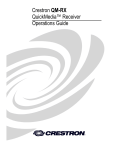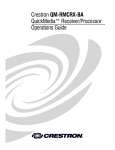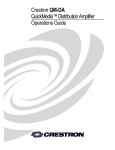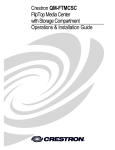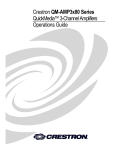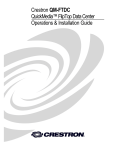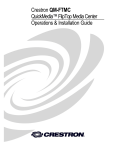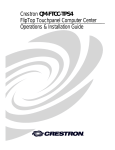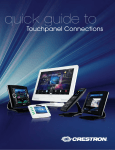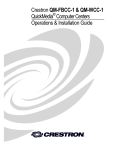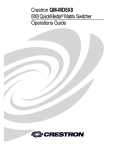Download Crestron QM-TX Specifications
Transcript
Crestron QM-TX QuickMedia™ Transmitter Operations Guide This document was prepared and written by the Technical Documentation department at: Crestron Electronics, Inc. 15 Volvo Drive Rockleigh, NJ 07647 1-888-CRESTRON All brand names, product names and trademarks are the property of their respective owners. ©2005 Crestron Electronics, Inc. Crestron QM-TX QuickMedia™ Transmitter Contents QuickMedia™ Transmitter: QM-TX 1 Introduction ..........................................................................................................1 Features and Functions...........................................................................1 QuickMedia Transport System...............................................................2 Part Number Compatibility ....................................................................3 Specifications .........................................................................................4 Physical Description...............................................................................5 Industry Compliance ..............................................................................8 Setup.....................................................................................................................9 Network Wiring .....................................................................................9 QM Network Wiring ............................................................................10 Installer’s Toolbox ...............................................................................10 Identity Code........................................................................................11 Hardware Hookup ................................................................................14 Ground Wire Connections....................................................................15 Configuration Software ......................................................................................15 Earliest Version Software Requirements for the PC ............................15 Programming with Crestron SystemBuilder ........................................16 Configuring with SIMPL Windows .....................................................21 Example Program.................................................................................24 Uploading and Upgrading ..................................................................................24 Communication Settings ......................................................................25 Troubleshooting Communications .......................................................27 Uploading a SIMPL Windows Program ..............................................28 Firmware Upgrade via Installer’s Toolbox ..........................................30 Problem Solving .................................................................................................32 Troubleshooting ...................................................................................32 Further Inquiries...................................................................................32 Future Updates .....................................................................................32 Appendix - QM Auto Compensation..................................................................33 Return and Warranty Policies.............................................................................34 Merchandise Returns / Repair Service .................................................34 CRESTRON Limited Warranty ...........................................................34 Operations Guide – DOC. 6334 Contents • i Crestron QM-TX QuickMedia™ Transmitter QuickMedia™ Transmitter: QM-TX Introduction Features and Functions The QM-TX is a Crestron® QuickMedia™ (QM) transmitter designed to provide cost-effective RGB, video, and audio signal routing and control as part of a complete MediaManager A/V presentation system. Using Crestron's exclusive QuickMedia transport, the QM-TX transmits RGB, video and audio signals over a single inexpensive CAT5E or CAT6 cable to any QuickMedia receiver. The QM-TX accepts composite video, S-video, component video, RGBHV, and audio signals. These signals are encoded and converted to the QuickMedia standard and fed over a CAT5E or CAT6 cable to a QM receiver. All signal routing occurs automatically under the command of the control system. The QuickMedia transport supports the transmission of RGB signals with resolutions up to 1600 x 1200 pixels at 60 Hz. Functional Summary • Programmable logic via Crestron SystemBuilder™, SIMPL Windows, and SIMPL+®. • One set of video inputs consisting of five BNC connectors. • Balanced/unbalanced stereo audio input. • Supports RGBHV, component, composite and S-video formats. • Two Cresnet® ports for loop-through connection and power supply. • Auto-detection of video signals • QuickMedia port for simplified A/V wiring and connection to QuickMedia receivers. Complete MediaManager systems can be configured easily to suit a variety of applications using Crestron SystemBuilder™ and SIMPL windows software. Operations Guide – DOC. 6334 QuickMedia™ Transmitter: QM-TX • 1 QuickMedia™ Transmitter Crestron QM-TX Block Diagram of the QM-TX NOTE: The QM-TX is compatible with 2-Series control systems only. QuickMedia Transport System Using a new, proprietary signal routing solution, signals such as composite video, S-video, RGBHV, audios, and microphone, are all transported using a single cable solution called QuickMedia (QM). The QM transport system port is capable of managing computer, video, and audio signals simultaneously through one CAT5E or CAT6 UTP (unshielded twisted pair) wire, simplifying installations. Routing CAT5E or CAT6 UTP cable is less expensive and much simpler than routing multi-colored, multi-conductor coax cable. All Crestron products using the QM transport system are capable of sending and receiving QM signals via standard CAT5E or CAT6 cable. Installation of any QM device is as simple as installing one set of QM wires from output to input. Installations are flexible, affordable, and fast. The Crestron QuickMedia cable “CRESCAT-QM” contains one CAT5E cable and one Cresnet® cable in siamese jackets. NOTE: Do not untwist the two wires in a single pair for more than 1/3-1/2" (0.84 – 1.27 cm) when making a connection. The twists are critical to canceling out interference between the wires. CRESCAT-QM Cable The QuickMedia transport mechanism performs delay compensation on each video input to compensate for signal skew, and frequency/bandwidth 2 • QuickMedia™ Transmitter: QM-TX Operations Guide - DOC. 6334 Crestron QM-TX QuickMedia™ Transmitter compensation for cable length. Signal skew occurs when part of the signal is delayed with respect to other signal components. The amount of skew largely depends on the length and design of the wire. Because CAT5 consists of twisted pairs that are twisted together in the cable, unequal wire lengths are created. The maximum aggregate cable length from QM transmitter to QM receiver is limited by the loss of bandwidth over long distances and the amount of available skew compensation. A cable rated at 15 ns of skew per 100 meters (328 ft.) means that a cable will have no more than a 15 ns difference between the fastest and slowest RGB signals over 100 meters of cable. To determine the allowable maximum length of installed cable, the installer must first perform a calculation based on the skew rating of the cable. The use of low-resolution signals may allow increased cable length but must be tested with the sources to be used. In any case, the maximum aggregate cable length should be limited to 328 feet to prevent loss of bandwidth. Skew compensation is primarily relevant to RGB sources; however, any/all video or VGA signals may experience a loss of quality over very long lengths of cable. This phenomenon is due to the added resistance and capacitance of longer cable lengths, and is not particular to either Crestron and/or QuickMedia systems. To ensure sufficient bandwidth to support signal resolutions up to 1600 x 1200, the maximum aggregate cable length should not exceed 328 feet. The use of lower-resolution signals may allow increased cable length but must be tested by the installer with the sources to be used. The pin assignment is based on the EIA/TIA 568B RJ-45 Jack standard. The following table illustrates how composite, S-video, and RGB video signals are transmitted over the CAT5E wire. Refer to page 10 for additional QuickMedia network wiring information. RJ-45 QuickMedia Connector Pin and Pair Assignment RJ-45 PIN NUMBER WIRE COLORS 1 WHITE/ORANGE - RGB RED 2 ORANGE + RGB RED + CHROMINANCE 3 WHITE/GREEN - RGB GREEN - LUMINANCE MALE RJ-45 CONNECTOR (EIA 568B) QM ASSIGNMENT RGB AND AUDIO QM ASSIGNMENT COMPOSITE, S-VIDEO AND AUDIO - CHROMINANCE 4 BLUE + AUDIO + AUDIO 5 WHITE/BLUE - AUDIO - AUDIO 6 GREEN + RGB GREEN + LUMINANCE 7 WHITE/BROWN - RGB BLUE - COMPOSITE 8 BROWN + RGB BLUE + COMPOSITE Part Number Compatibility Due to production changes, some earlier QM-RMCRX devices are not compatible with QM-TX devices. To ensure compatibility between a QM-RMCRX and QM-TX, The QM-RMCRX Part Number must be 6002432 or above. NOTE: Part numbers can be found on the silver label affixed to each device. If you have a part that is not compatible with your existing equipment, contact Crestron's Customer Support Group for replacement information. Operations Guide – DOC. 6334 QuickMedia™ Transmitter: QM-TX • 3 QuickMedia™ Transmitter Crestron QM-TX Specifications Specifications for the QM-TX are given in the following table. QM-TX Specifications SPECIFICATION DETAILS Cresnet Power Usage 5 W (0.21 A @ 24 VDC) Default Cresnet ID 1B Firmware Version 1.04 2-Series Control 1,2 System Update Files Version 3.125.CUZ or later Ports/Connectors Video Input Five BNC input connectors for composite, component, S-video and RGBHV Input Audio Input One 5-pin balanced/unbalanced audio mini connector Maximum line level 4 V RMS balanced, 2 V RMS unbalanced Input impedance 10 K Ohm Bandwidth 20 Hz to 20 KHz QM Output One QuickMedia 8-wire RJ-45 QuickMedia output port Connects via CAT5e or CAT6 to a QM receiver. (Refer to the note following the specifications table) Cresnet Two 4-pin 3.5 mm detachable terminal blocks. Connects to Cresnet control network Composite Video Gain 0 dB (Unity gain, 75 Ohm termination), for 1.0 V p-p maximum input. RGB Gain 0 dB (Unity gain, 75 Ohm termination), for 0.7 V p-p maximum input. RGB Horizontal and Vertical Sync 5 V p-p maximum into 620 Ohms. S-Video Gain Luminance: 0 dB (Unity gain, 75 Ohm termination), for 1 V p-p maximum input. Chrominance: 0 dB (Unity gain, 75 Ohm termination), for 0.7 V p-p maximum input. Environmental Temperature 41° to 104°F (5° to 40°C) Environmental Humidity 10% to 90% RH (non-condensing) Dimensions & Weight Height: Width: Depth: Weight: 1.80 in (4.58 cm) 7.07 in (17.96 cm) 7.02 in (17.83 cm) 2.05 lb (0.93 kg) 1. The latest software versions can be obtained from the Downloads | Software Updates section of the Crestron website. Refer to the NOTE following these footnotes. 2. Crestron 2-Series control systems include the AV2 and PRO2. Consult the latest Crestron Product Catalog for a complete list of 2-Series control systems. NOTE: Crestron software and any files on the website are for Authorized Crestron dealers and Crestron Authorized Independent Programmers (CAIP) only. New users may be required to register to obtain access to certain areas of the site (including the FTP site). NOTE: CAT5E/CAT6 cable must have a delay skew of less than 22 ns (15 ns when using with the QM-RMCRX) per 100 m for use with the QuickMedia transport. Purchase CresCAT-QM for the most cost-effective cabling solution. Maximum aggregate cable length is 300 feet from QM transmitter to QM receiver. A maximum of two QM distribution centers may be inserted in-line. Refer to page 10 for additional details. 4 • QuickMedia™ Transmitter: QM-TX Operations Guide - DOC. 6334 Crestron QM-TX QuickMedia™ Transmitter Physical Description The QM-TX is housed in a black enclosure with labels on the front and rear panels. On the front of the unit there are three LEDs for indicating the unit’s current status. All connections are made on the back of the unit. There are four rubber feet on the base of the unit for stability and to prevent slippage. Refer to the following physical views. QM-TX Front View QM-TX Rear View Operations Guide – DOC. 6334 QuickMedia™ Transmitter: QM-TX • 5 QuickMedia™ Transmitter Crestron QM-TX QM-TX Physical Dimensions Indicators The QM-TX indicators are located on the front panel and are described as follows. PWR (Power) This green LED illuminates when the unit is connected to Cresnet and receives 24 VDC. NET This yellow LED illuminates when the QM-TX communicates with any device on the network. VIDEO ACT The red VIDEO ACT LED (video activity) illuminates when a video signal is present on the BNC input connectors. 6 • QuickMedia™ Transmitter: QM-TX Operations Guide - DOC. 6334 Crestron QM-TX QuickMedia™ Transmitter Ports The QM-TX ports are located on the rear panel and are illustrated and described as follows. Video and RGB Inputs Five BNC type connectors are provided for video and RGB input. Composite video is a type of video signal in which all information – the red, green, and blue (horizontal and vertical sync) signals are mixed together. S-video contains two separate components, luminance and chrominance (also known as Y and C signals respectively). The luminance signal contains brightness, intensity, and signal timing information. This signal contains all picture information except for color. The chrominance signal contains only the color information. You can see the complete black and white image, without the chrominance, by only feeding the luminance signal into a monitor. RGB is comprised of three analog video signals: red, green, blue and separate horizontal and vertical syncs. Most computer monitors use RGB (usually called VGA, SVGA, XVGA, etc.). RGBHV consists of red (R), green (G), blue (B), horizontal sync (H) and vertical sync (V). Video sensing occurs on the H, COMP, and Y connectors. RGsB format is RGB with sync on Green, and RGBS is RGB with composite sync. Component video contains three parts. The luminance signal (Y) contains the black & white (brightness) information in the original RGB signal. The color difference signal B-Y (PB) contains the blue information, minus the luminance information. The color difference signal R-Y (PR) contains the red information minus the luminance information. The color difference channels (B-Y and R-Y) are algebraically recombined with the luminance channel to produce a full color picture, recreating the green information through this mathematical process. AUDIO (Input) This 5-pin terminal block connector provides balanced/unbalanced left and right audio signal input. Balanced audio inputs use (+) and (-) inputs and a separate shield (ground). Unbalanced audio input uses L and R (+) inputs for left and right signal and connects (-) to ground connector (G). Maximum line level is 4 VRMS balanced, 2 V RMS unbalanced. Input impedance is 10 K Ohm. Bandwidth is 20 Hz to 20 KHz. Operations Guide – DOC. 6334 QuickMedia™ Transmitter: QM-TX • 7 QuickMedia™ Transmitter 1 QM 8 Crestron QM-TX QM (Output) The 8-pin RJ-45 QuickMedia transport port outputs CAT5E/CAT6 video and audio signals. The QM output port conforms to the 568B wiring standard. Refer to page 2 for additional wiring information. NOTE: To determine the location of pin 1 on a male RJ-45 plug, hold the connector so that the cable is down and the clip is facing away from you. Pin 1 is on the far left. NET The two 4-pin 5 mm detachable terminal block NET connectors are used for connection to Cresnet and expansion to other peripherals. Pins 24 and G provide 24 VDC and ground. Pins Y and Z provide communications (data). Power to the unit (5 W, 0.21 A @ 24 VDC) is supplied through this connector. SETUP LED and Pushbutton Used for touch-settable ID (TSID) and located on the back of the unit, the SETUP pushbutton and its associated LED are used for setting a network ID during the initial configuration of a Cresnet system or when the device is added or replaced. Industry Compliance As of the date of manufacture, the QM-TX has been tested and found to comply with specifications for CE marking and standards per EMC and Radiocommunications Compliance Labelling. NOTE: This device complies with part 15 of the FCC rules. Operation is subject to the following two conditions: (1) this device may not cause harmful interference, and (2) this device must accept any interference received, including interference that may cause undesired operation. 8 • QuickMedia™ Transmitter: QM-TX Operations Guide - DOC. 6334 Crestron QM-TX QuickMedia™ Transmitter Setup Network Wiring CAUTION: In order to ensure optimum performance over the full range of your installation topology, Crestron Certified Wire, and only Crestron Certified Wire, should be used. Failure to do so, may incur additional charges if support is required to identify performance deficiencies as a result of using improper wire. CAUTION: Provide sufficient power to the system. Insufficient power can lead to unpredictable results or damage to the equipment. Please use the Crestron Power Calculator to help calculate how much power is needed for the system (http://www.crestron.com/calculators). CAUTION: Use only Crestron power supplies for Crestron equipment. Failure to do so could cause equipment damage or void the Crestron warranty. NOTE: When installing network wiring, refer to the latest revision of the wiring diagram(s) appropriate for your specific system configuration, available from the Crestron website. When calculating the wire gauge for a particular Cresnet run, the length of the run and the Cresnet power usage of each network unit to be connected must be taken into consideration. If Cresnet units are to be daisy-chained on the run, the Cresnet power usage of each unit to be daisy-chained must be added together to determine the Cresnet power usage of the entire chain. If the unit is a home-run from a Crestron system power supply network port, the Cresnet power usage of that unit is the Cresnet power usage of the entire run. The length of the run in feet and the Cresnet power usage of the run should be used in the resistance equation below to calculate the value on the right side of the equation. Resistance Equation The required wire gauge should be chosen such that the resistance value is less than the value calculated in the resistance equation. Refer to the following table. Wire Gauge Values RESISTANCE WIRE GAUGE 4 16 6 18 10 20 15 22 13 Doubled CAT5 8.7 Tripled CAT5 NOTE: All Cresnet wiring must consist of two twisted pairs. One twisted pair is the +24V conductor and the GND conductor, and the other twisted pair is the Y conductor and the Z conductor. Operations Guide – DOC. 6334 QuickMedia™ Transmitter: QM-TX • 9 QuickMedia™ Transmitter Crestron QM-TX NOTE: When daisy-chaining Cresnet units, strip the ends of the wires carefully to avoid nicking the conductors. Twist together the ends of the wires that share a pin on the network connector, and tin the twisted connection. Apply solder only to the ends of the twisted wires. Avoid tinning too far up the wires or the end becomes brittle. Insert the tinned connection into the Cresnet connector and tighten the retaining screw. Repeat the procedure for the other three conductors. NOTE: For additional information on video connections over CAT5, refer to the latest version of the Crestron CAT5 Wiring Reference Guide (Doc. 6137) which is available from Crestron website (http://www.crestron.com/manuals). NOTE: For larger networks (i.e., greater than 28 network devices), it may be necessary to add a Cresnet Hub/Repeater (CNXHUB) to maintain signal quality throughout the network. Also, for networks with lengthy cable runs or varying types of network devices, it may be desirable to add a hub/repeater after only 20 network devices. QM Network Wiring For the QuickMedia transport, use CRESCAT-QM cable. The aggregate cable length from transmitter to receiver cannot have a delay skew of more than 22 ns for a given signal path originating at a QM transmitter and terminating at a QM receiver. The aggregate cable length must not exceed 328 feet. When connecting multiple QM devices, the route between a QM origination point (transmitter) and a QM endpoint (receiver) cannot have more than two midpoints (e.g., QM-MD7x2 or other QM switchers). Refer to the following diagram when configuring a QM network. QM Network Topology Installer’s Toolbox The Installer's Toolbox (a replacement for Crestron Viewport, you may continue to use Viewport if desired) is a broad-based software package that accomplishes multiple system tasks, primarily using an RS-232 or TCP/IP connection between a PC and one or more Crestron control systems. You can use the Installer's Toolbox to: • Observe system processes. • Upload operating systems and firmware. 10 • QuickMedia™ Transmitter: QM-TX Operations Guide - DOC. 6334 Crestron QM-TX QuickMedia™ Transmitter • Upload programs and touchpanel projects. • Set or change device Network IDs. • Change serial numbers. • Run scripts to automate tasks. • Perform system diagnostics, and much more. The Installer's Toolbox allows you to perform these functions using simple graphical views and click and drag methods. Identity Code Every equipment and user interface within the network requires a unique identity code (Net ID). These codes are two-digit hexadecimal numbers from 03 to FE. The Net ID of each unit must match an ID code specified in the SIMPL Windows program. Refer to “Setting the Net ID in Device Settings” on page 22 for details of the SIMPL Windows procedure. The Net ID of the QM-TX has been factory set to 1B. The Net IDs of multiple QM-TXs in the same system must be unique. Net IDs are changed from a personal computer (PC) via the Crestron Installer’s Toolbox. NOTE: For detailed information on establishing communication between the PC, control system, and the QM-TX, refer to “Communication Settings” on page 25. If communication cannot be established, refer to the “Troubleshooting Communications” section in the latest version of the 2-Series Control System Reference Guide (Doc. 6256), which is available from the Crestron website. The Installer's Toolbox provides several methods to easily set or change device Net IDs for any device on the network. The following method permits you to change the Net ID of any device in the network through the “Network Device Tree” window. NOTE: This method prevents you from setting duplicate IDs. This method permits you to manually set the Net ID for any device in the network, can be used to set any known Net IDs that may require changing, and may also be used for non-TSID equipment. This method will not permit you to choose an ID already in use by another device. A warning message will appear if you attempt to use an ID that is already in use. Duplicate Net ID Warning Message This method does not change the Net ID as assigned in SIMPL windows. NOTE: You may also use SystemBuilder to perform Network ID setup. Refer to page 19 for Network ID setup details using SystemBuilder. 1. Operations Guide – DOC. 6334 Ensure that all network devices are connected to the control system. QuickMedia™ Transmitter: QM-TX • 11 QuickMedia™ Transmitter Crestron QM-TX 2. Open Installer’s Toolbox and select the Network Device Tree icon, or select Tools | Network Device Tree. 3. Select the connection using the pull down list in the lower left corner or click “Click here to select connection…” to open the address book window. Network Device Tree – Pull Down Connection List 4. Select the connection (TCP or serial) and click OK. Network Device Tree – “Address Book” Window 5. The Network Device Tree displays all devices on the current network. 12 • QuickMedia™ Transmitter: QM-TX Operations Guide - DOC. 6334 Crestron QM-TX QuickMedia™ Transmitter Installer’s Toolbox – “Network Device Tree” 6. Right-click on the device, and when the sub-menu appears, select Change Network ID. “Network Device Tree” – Sub-Menu 7. Select a new Net ID and press Enter. Enter New Net ID Repeat this procedure for each additional network device requiring a Net ID change. Operations Guide – DOC. 6334 QuickMedia™ Transmitter: QM-TX • 13 QuickMedia™ Transmitter Crestron QM-TX Hardware Hookup Refer to the following hookup diagram and, aside from attaching power last, complete the connections in any order. NOTE: To prevent overheating, do not operate this product in an area that exceeds the environmental temperature range listed in the specifications table. Consideration must be given if installed in a closed or multi-unit rack assembly since the operating ambient temperature of the rack environment may be greater than the room ambient. Contact with thermal insulating materials should be avoided on all sides of the unit. NOTE: The maximum continuous current from equipment under any external load conditions shall not exceed a current limit that is suitable for the minimum wire gauge used in interconnecting cables. The ratings on the connecting unit's supply input should be considered to prevent overloading the wiring. QM-TX Hookup Connections Video Input Connections 14 • QuickMedia™ Transmitter: QM-TX Operations Guide - DOC. 6334 Crestron QM-TX QuickMedia™ Transmitter Ground Wire Connections Proper grounding is required. Connect the ground from the QM-TX to earth ground. Connect the Cresnet shield lead at the control processor to the ground lead. The control processor chassis must also be connected to an earth ground (building steel). Refer to the following grounding diagram. Ground Wire Connections NOTE: Do not connect the shield to earth ground at the QM receiver (in this example, the QM-RX) Configuration Software Have a question or comment about Crestron software? Answers to frequently asked questions (FAQs) can be viewed in the Online Help section of the Crestron website. To post a question or view questions you have submitted to Crestron’s True Blue Support, log in at http://support.crestron.com. First-time users will need to establish a user account. Configuration is easy thanks to Crestron’s Windows-based programming software. Crestron SystemBuilder software creates a complete project, with no special programming required. SystemBuilder completes all necessary programming for a base system including all touchpanel screens and the control system program. The program output of SystemBuilder is a SIMPL Windows program with much of the functionality encapsulated in macros and templates. Once SystemBuilder creates the project, the system interfaces and program logic can be customized in SystemBuilder or can be easily modified with Crestron development tools, i.e., SIMPL Windows and Crestron VisionTools Pro-e (VT Pro-e) software packages. SystemBuilder comes with templates for all supported interfaces. If a user wishes to create a touchpanel project using templates with a different look-andfeel, this can be accomplished by making a custom template. This custom template can then be used by SystemBuilder to create the final project files to be loaded into the panels. Alternatively, VT Pro-e can be used to tweak projects created with the SystemBuilder or develop original touchpanel screen designs. Earliest Version Software Requirements for the PC NOTE: Crestron recommends that you use the latest software to take advantage of the most recently released features. The latest software is available from the Crestron website Operations Guide – DOC. 6334 QuickMedia™ Transmitter: QM-TX • 15 QuickMedia™ Transmitter Crestron QM-TX NOTE: Crestron software and any files on the website are for Authorized Crestron dealers and Crestron Authorized Independent Programmers (CAIP) only. New users are required to register to obtain access to certain areas of the site (including the FTP site). The following are the earliest useable software version requirements for the PC: • SIMPL Windows version 2.06 or later, Library 328 and SIMPL+ Cross Compiler version 1.1. • Crestron Database version 16.4.0 or later. Required by SIMPL Windows. • Installer’s Toolbox version 1.0 or later. • (Optional but highly recommended) SystemBuilder version 2.0. SystemBuilder 2.0 will require later versions of these software programs: SIMPL Windows, Library, VT Pro-e, Crestron database, and Crestron Engraver. Programming with Crestron SystemBuilder The easiest method of programming, but does not offer as much flexibility as SIMPL Windows. Crestron SystemBuilder offers automatic programming for such residential and commercial applications as audio distribution, home theater, video conferencing, and lighting. The interface of this tool guides you through a few basic steps for designating rooms and specifying the control system, touchpanels, devices, and functionality. Crestron System Builder then programs the system, including all touchpanel projects and control system logic. Crestron System Builder is fully integrated with Crestron's suite of software development tools, including SIMPL Windows, VT Pro-e, Crestron Database, User IR Database, and User Modules Directory. Crestron System Builder accesses these tools behind the scenes, enabling you to easily create robust systems. NOTE: Modifications to the program that are made outside of SystemBuilder (for example, in VT Pro-e or SIMPL windows) are not preserved if you reenter SystemBuilder. SystemBuilder 16 • QuickMedia™ Transmitter: QM-TX Operations Guide - DOC. 6334 Crestron QM-TX QuickMedia™ Transmitter After entering the appropriate information in each step, SystemBuilder creates the control system logic and touchpanel pages, ready to upload to the controller. NOTE: Crestron SystemBuilder version 2.0 or higher is required. Creating a QuickMedia System in SystemBuilder The following information is a general procedure for setting up a QuickMedia system using SystemBuilder. Refer to the SystemBuilder help file for more detailed instructions. 1. Open SystemBuilder and select File | New. Select a Blank System. SystemBuilder – New Blank System 2. Select the plug-in for a QuickMedia system. SystemBuilder – “Plug-in Selection” Window 3. Operations Guide – DOC. 6334 Select the control processor. QuickMedia™ Transmitter: QM-TX • 17 QuickMedia™ Transmitter Crestron QM-TX SystemBuilder – Select a Control Processor 4. Specify the audio configuration. 5. Add RoomView™ if desired. 6. and Click the Assign QuickMedia Devices and Routing button drag the QM-TX from the library on the right side, to the QM system on the left side. SystemBuilder – Equipment Room 18 • QuickMedia™ Transmitter: QM-TX Operations Guide - DOC. 6334 Crestron QM-TX QuickMedia™ Transmitter 7. Setup QM network cable routing. 8. Build the program. 9. Upload the program to the control processor. SystemBuilder – System View Setting Net IDs in SystemBuilder SystemBuilder provides a convenient method of selecting and assigning Network IDs to devices. 1. Ensure that all network devices are connected to the control system. 2. After completing your SystemBuilder program, click the Build and Upload button Operations Guide – DOC. 6334 . QuickMedia™ Transmitter: QM-TX • 19 QuickMedia™ Transmitter Crestron QM-TX SystemBuilder – “Finish” Window 3. On the Finish window, click the Set Network IDs… button to assign the network IDs. SystemBuilder provides three methods for assigning Net IDs and reconciling IDs of connected devices to the program. • Drag and drop a device from the program tree on the left onto the device in the network tree on the right. • Right-click a device the program tree on the left and select Setup from the sub-menu. • Right-click on a device in the network tree on the right and set the Net ID directly. SystemBuilder – “Set Network IDs” Window 20 • QuickMedia™ Transmitter: QM-TX Operations Guide - DOC. 6334 Crestron QM-TX QuickMedia™ Transmitter Configuring with SIMPL Windows NOTE: The following are acceptable file extensions for programs that include a QM-TX, developed for specific control system types: .smw projectname.smw (source file) .spz projectname.spz (compiled file for 2-Series) .usp projectname.usp (source code module for SIMPL+) .ir projectname.ir (user IR) .umc projectname.umc (user macro) .ush projectname.ush (completed SIMPL+) SIMPL Windows is the Crestron graphical, Windows®-based development tool for programming control systems. The SIMPL Windows interface provides two workspaces: the Configuration Manager, for configuring the control system, touchpanels, and controlled network devices; and Program Manager, for designing the logic and functionality of the control system. In addition, you can use the powerful Crestron Viewport utility to accomplish multiple system tasks, such as uploading the program to the control system and performing diagnostic functions. NOTE: The information in this section assumes that the reader has knowledge of SIMPL Windows. If not, refer to the extensive help information provided with the software. NOTE: The QM-RMCRX control system is used in the following descriptions. This section describes a sample SIMPL Windows program that includes a QM-TX. Configuration Manager is where programmers “build” a Crestron control system by selecting hardware from the Device Library. In Configuration manager, drag the QM-RMCRX from the Control Systems folder of the Device Library and drop it in the upper pane of the System Views. The QM-RMCRX with its associated communication ports is displayed in the System Views upper pane. QM-RMCRX System View The System Views lower pane displays the QM-RMCRX system tree (refer to the following graphic). This tree can be expanded to display and configure the communication ports. Operations Guide – DOC. 6334 QuickMedia™ Transmitter: QM-TX • 21 QuickMedia™ Transmitter Crestron QM-TX Expanded QM-RMCRX System Tree C2Net-Device Slot in Configuration Manager To incorporate a QM-TX into the system, drag the QM-TX from the Cresnet Control Modules | QM Series folder of the Device Library and drop it in System Views. The QM-RMCRX system tree displays the QM-TX in Slot 5, with a default Net ID of 1B as shown in the following illustration. NOTE: The first QM-TX in a system is preset with a Net ID of 1B when its symbol is dragged into the upper pane of System Views. Additional units are assigned different Net ID numbers as they are added. Setting the Net ID in SIMPL Windows Double-click the QM-TX icon in the upper pane to open the “Device Settings” window. This window displays QM-TX device information. The Net ID can be changed in this window using the Net ID tab, as shown in the following figure. 22 • QuickMedia™ Transmitter: QM-TX Operations Guide - DOC. 6334 Crestron QM-TX QuickMedia™ Transmitter “Device Settings” Window NOTE: This procedure sets the Net ID for the QM-TX in the program only. It does not automatically set the Net ID for the QM-TX itself. SIMPL Windows automatically changes Net ID values of a device added to a program if a duplicate device or a device with the same Net ID already exists in the program. Always ensure that the hardware and software settings of the Net ID match. For Net ID hardware setting details, refer to “Identity Code” on page 10. QM-TX Symbol in Programming Manager Programming Manager is where programmers “program” a Crestron control system by assigning signals to symbols. Click the plus sign of the QM-TX to reveal the available slot. Open the QM-TX symbol in Detail View. Detail View of QM-TX Symbol The QM-TX symbol contains three digital detection lines for RGB, composite and component video detection <RGB Detect>, <Composite Detect>, and <Y Pb Pr Detect>. The analog <AudioComp> input and feedback is the volume adjustment for the program audio input, -10dB to +10dB (-100 to +100 input value). This control originates on the QM transmitter and is sent over QM with auto-compensation to the receiver. Actual adjustment is performed at the receiving end (QM-AE, QM-RMCRX, QM-MD7x2, etc.). Operations Guide – DOC. 6334 QuickMedia™ Transmitter: QM-TX • 23 QuickMedia™ Transmitter Crestron QM-TX QM-TX Symbol Signals SIGNAL TYPE AND NAME DESCRIPTION Digital output <RGB Detect> Indicates that TTL H-sync is detected at the video input. The feedback remains high for as long as the signal is detected. High/1 = Computer video detected; Low/0 = No video detected Digital output <Composite Detect> Indicates that composite video is detected at the video input. The feedback remains high for as long as the signal is detected. High/1 = Composite video detected; Low/0 = No video detected Digital output <YPbPr Detect> Indicates that component or S-Video video is detected at the video input. The feedback remains high for as long as the signal is detected. High/1 = Component video or S-Video detected; Low/0 = No video detected Analog input <AudioComp> Sets the source gain compensation for the AUDIO source. The source gain compensation will be applied at any QM destination that has audio auto-compensation enabled. Valid analog values range from -100d (-10dB) to +100d (+10dB), adjustable in increments of 0.1dB (1d = 0.1dB). Out of range values will clip the compensation to the minimum or maximum value. Analog output <AudioComp_F> Indicates the source gain compensation being applied to the AUDIO source. Example Program An example program for the QM-TX is available from the “Example Program” section of the Crestron website (http://www.crestron.com/exampleprograms). Uploading and Upgrading NOTE: Crestron recommends that you use the latest software and that each device contains the latest firmware to take advantage of the most recently released features. Please check the Crestron website (http://www.crestron.com/updates) for the latest versions of software and firmware. New users are required to register to obtain access to this site. Assuming a PC is properly connected to the entire system, Crestron programming software allows the programmer to upload programs, projects and firmware to the system and touchpanels after their development. However, there are times when the files for the program and projects are compiled and not uploaded. Instead, compiled files may be distributed from programmers to installers, from Crestron to dealers, etc. Even firmware upgrades are available from the Crestron website as new features are developed after product releases. In those instances, one has the option to upload via the programming software or to upload and upgrade via the Crestron Installer’s Toolbox. 24 • QuickMedia™ Transmitter: QM-TX Operations Guide - DOC. 6334 Crestron QM-TX QuickMedia™ Transmitter The following sections define how one would upload a SIMPL Windows program to the control system and upgrade the firmware of the QM-TX. However, before attempting to upgrade or upload, it is necessary to establish communications. Communication Settings NOTE: For laptops and other PCs without a built-in RS-232 port, Crestron recommends the use of PCMCIA cards, rather than USB-to-serial adapters. If a USB-to-serial adapter must be used, Crestron has tested the following devices with good results: Belkin (large model) F5U103 I/O Gear GUC232A (discontinued) Keyspan USA-19QW (discontinued) Other models, even from the same manufacturer, may not yield the same results. NOTE: Even with these recommended models, results may vary on the computer being used. The procedure in this section provides details for RS-232 communication between the PC and the control system. If TCP/IP communication is preferred, consult the latest version of the Crestron e-Control Reference Guide (Doc. 6052) or the respective Operations Guide for the control system. These documents are available from the Crestron website. Refer to the following figure for a typical connection diagram when uploading files. Typical Connection Diagram when Uploading NOTE: Use a standard DB9 “Null-Modem” RS-232 cable when communicating with a QuickMedia control processor. Use a straight through cable when communicating with a 2-Series control processor. Serial Connection 1. Operations Guide – DOC. 6334 Ensure that all devices are connected to the control processor and the control processor is connected via serial cable to the PC. QuickMedia™ Transmitter: QM-TX • 25 QuickMedia™ Transmitter Crestron QM-TX 2. Open Installer’s Toolbox and click Tools | Manage Address Book to display the communications settings. Enter the new address name, and then click RS-232 as the connection type. 3. The PC communication settings specified here should match the protocol that the control processor expects. The usual settings are as follows: • Port = COM 1 through COM 8. Select the correct COM port on the PC. • Baud rate = 115200. • Parity = None. • Number of data bits = 8. • Number of stop bits = 1. • Hardware handshaking (RTS/CTS) enabled. • Software handshaking (XON/XOFF) not enabled. “Address Book” Window – Serial Settings 4. After setting the correct parameters, click OK to return to the Installer’s Toolbox main window. 5. Click Tools | Network Device Tree to display the devices in the system. TCPIP Connection 1. Ensure that all devices are connected to the control processor. For TCP/IP, use CAT5 straight through cables with 8-pin RJ-45 connectors to connect the LAN port on the control processor and the LAN port on the PC to the Ethernet hub. Alternatively, you can use a CAT5 crossover cable to connect the two LAN ports directly, without using a hub. The following table illustrates pinouts for straight through and crossover RJ-45 cables. Pins 4, 5, 7, and 8 are not used. 26 • QuickMedia™ Transmitter: QM-TX Operations Guide - DOC. 6334 Crestron QM-TX QuickMedia™ Transmitter RJ-45 Straight Through Cable FROM PIN COLOR SIGNAL TO PIN SIGNAL 1 White/Orange 2 Orange Tx+ 1 Tx+ Tx- 2 Tx- 3 White/Green 6 Green Rc+ 3 Rc+ Rc- 6 Rc- RJ-45 Crossover Cable FROM PIN COLOR SIGNAL TO PIN SIGNAL 1 White/Orange Rc+ 3 Tx+ 2 Orange Rc- 6 Tx- 3 White/Green Tx+ 1 Rc+ 6 Green Tx- 2 Rc- 2. Once the cable connections are made, open Installer’s Toolbox. Click Tools | Manage Address book to display the “Address Book” window and enter the new address name. Then click TCP as the connection type. Enter the IP address or hostname of the control processor. “Address Book” Window – TCP Settings 3. After setting the correct parameters, click OK to return to the Installer’s Toolbox main window. 4. Click Tools | Network Device Tree to display the devices in the system. Troubleshooting Communications Use the following checklist if communication cannot be established with the control processor. 1. Operations Guide – DOC. 6334 Verify that you are using the correct cables. As described previously, an RS-232 connection to a QuickMedia control processor requires a QuickMedia™ Transmitter: QM-TX • 27 QuickMedia™ Transmitter Crestron QM-TX null modem RS-232 cable. Serial connection to a 2-Series control processor requires a straight through cable. Direct TCP/IP connection requires a straight through CAT5 cable with 8-pin RJ-45 connectors. 2. With a serial connection, verify that the correct COM port on the PC has been selected. Some computers have more than one COM port; some may be internal (e.g., for a modem). Consult the manufacturer’s documentation for further information about the COM ports on your PC. 3. Remove and reapply power to the control system. 4. If communication still cannot be established, contact Crestron customer service. Uploading a SIMPL Windows Program A control system source file has the extension .smw. A compiled SIMPL Windows file has the extension .spz for a 2-Series control system. The SIMPL Windows file can be uploaded to the control system using SIMPL Windows or via Installer’s Toolbox. Upload via SIMPL Windows 1. Start SIMPL Windows. 2. Select File | Open to view the “Open” window, navigate to the SIMPL Window file (.smw), and click Open. 3. Select Project | Transfer Program. Upload via Installer’s Toolbox 1. Verify that the procedure for “Communication Settings” that begins on page 25 has been performed. 2. Open Installer’s Toolbox. 3. Select Tools | System Info. Installer’s Toolbox – Tools | System Info 4. When the “System Info” window appears, the Functions option becomes available from the menu bar. 5. Select Functions | SIMPL Program. 6. The “SIMPL Program” window contains information about the currently loaded SIMPL program (if any), and permits you to stop, 28 • QuickMedia™ Transmitter: QM-TX Operations Guide - DOC. 6334 Crestron QM-TX QuickMedia™ Transmitter start, erase, retrieve, and upload a SIMPL program. This menu also permits you to upload to compact flash or internal flash. “SIMPL Program” Window 7. Click the program. browse button to locate the new compiled (.spz) “Open” Window 8. Operations Guide – DOC. 6334 Select a file and click Open. When the SIMPL Program window reopens click Send. QuickMedia™ Transmitter: QM-TX • 29 QuickMedia™ Transmitter Crestron QM-TX Firmware Upgrade via Installer’s Toolbox To take advantage of all the QM-TX features, it is important that the unit contains the latest firmware available. Please check the Crestron website for the latest version of firmware. Not every product has a firmware upgrade, but as Crestron improves functions, adds new features, and extends the capabilities of its products, firmware upgrades are posted. To upgrade the firmware, complete the following steps. 1. Make sure that “Communication Settings,” which begins on page 25, has been performed. 2. Open Installer’s Toolbox. 3. Open the Network Device Tree (the firmware upgrade function is also available in the SMW Program Tree window). 4. Right-click on the device and select Functions | Firmware. “Network Device Tree” Window – Right-Click Sub Menu 5. The Firmware window displays the model and current firmware version. Click Upload New Firmware. “Firmware” Window 6. When the following screen appears, browse to locate the firmware (.upg) file. 30 • QuickMedia™ Transmitter: QM-TX Operations Guide - DOC. 6334 Crestron QM-TX QuickMedia™ Transmitter Locate Firmware in the “Open” Window 7. Click Open and the file transfers to the unit. “File Transfer” Window 8. The “Firmware” window indicates the new firmware version. 9. The QM-TX automatically reboots. Click Close after the QM-TX automatically reboots. “Firmware” Window – New Firmware Number Displayed Operations Guide – DOC. 6334 QuickMedia™ Transmitter: QM-TX • 31 QuickMedia™ Transmitter Crestron QM-TX Problem Solving Troubleshooting The following table provides corrective action for possible trouble situations. If further assistance is required, please contact a Crestron customer service representative. QM-TX Troubleshooting TROUBLE POSSIBLE CAUSE(S) CORRECTIVE ACTION PWR LED does not illuminate. The QM-TX is not receiving power. Verify that Cresnet is properly attached. Use only Crestron power supplies for Crestron equipment. No video output displayed. The cable connection is incorrect. Verify RGB, video, S-video input cable connection to unit and video display. No audio output transmitted. The audio connection is incorrect. Verify balanced audio input connection is secure. Wrong source or video displayed. Wrong SystemBuilder or SIMPL Windows programs. Verify and upload correct programs. Verify QM output cable connection is secure. SystemBuilder project not set Verify proper video set up for each video up correctly. input. Video is garbled or no output. The cable connections are incorrect. Verify video input cable connections and QM output cable connections are secure. Incorrect signal skew due to cable length or unequal pair length. Verify maximum QM cable length and skew adjustment at QM receiver. Incorrect peak and/or boost setting. Adjust peak or boost controls at receiver until image quality is improved. Further Inquiries If you cannot locate specific information or have questions after reviewing this guide, please take advantage of Crestron's award winning customer service team by calling the Crestron corporate headquarters at 1-888-CRESTRON [1-888-273-7876]. For assistance in your local time zone, refer to the Crestron website (www.crestron.com) for a listing of Crestron worldwide offices. You can also log onto the online help section of the Crestron website to ask questions about Crestron products. First-time users will need to establish a user account to fully benefit from all available features. Future Updates As Crestron improves functions, adds new features, and extends the capabilities of the QM-TX, additional information may be made available as manual updates. These updates are solely electronic and serve as intermediary supplements prior to the release of a complete technical documentation revision. Check the Crestron website periodically for manual update availability and its relevance. Updates are identified as an “Addendum” in the Download column. 32 • QuickMedia™ Transmitter: QM-TX Operations Guide - DOC. 6334 Crestron QM-TX QuickMedia™ Transmitter Appendix - QM Auto Compensation Each QM transmitter sends an ID number to identify itself to the QM receiver. The ID number enables the QM receiver to recall the appropriate preset cable compensation for the incoming signal received from a variety of sources. Each preset recalls five parameters: three skew numbers for RGB, one for Peak, and one for Boost. The QM receiver stores 254 presets. At the transmitter, the ID number can be either the transmitter's Cresnet ID or an arbitrary transmit ID number. The console command for the transmitter’s ID is xmitid, and the default is off, which means that the Cresnet ID is used. Normally, the command is xmitid is followed by the ID number, or by the word “OFF”. If no parameter is supplied, the device returns to the current state. On the receiving end, the ID number selects the presets for that source (RGB skew, peaking, boost, and microphone parameters). NOTE: The QM cable compensation is disabled if auto compensation on the receiver is disabled. When auto compensation is enabled, the receiving device is allowed to use the auto compensation data received from the transmitter. There is a digital join EnableVideoAutoComp on each receiver, and a corresponding console command QMDATARX ON/OFF. NOTE: Because video auto compensation travels on the audio line, it does not function when audio is split up from video as in the QM-MD4X2 or any QM switcher with audio breakaway. Operations Guide – DOC. 6334 QuickMedia™ Transmitter: QM-TX • 33 QuickMedia™ Transmitter Crestron QM-TX Return and Warranty Policies Merchandise Returns / Repair Service 1. No merchandise may be returned for credit, exchange, or service without prior authorization from CRESTRON. To obtain warranty service for CRESTRON products, contact the factory and request an RMA (Return Merchandise Authorization) number. Enclose a note specifying the nature of the problem, name and phone number of contact person, RMA number, and return address. 2. Products may be returned for credit, exchange, or service with a CRESTRON Return Merchandise Authorization (RMA) number. Authorized returns must be shipped freight prepaid to CRESTRON, 6 Volvo Drive, Rockleigh, N.J. 07647, or its authorized subsidiaries, with RMA number clearly marked on the outside of all cartons. Shipments arriving freight collect or without an RMA number shall be subject to refusal. CRESTRON reserves the right in its sole and absolute discretion to charge a 15% restocking fee, plus shipping costs, on any products returned with an RMA. 3. Return freight charges following repair of items under warranty shall be paid by CRESTRON, shipping by standard ground carrier. In the event repairs are found to be non-warranty, return freight costs shall be paid by the purchaser. CRESTRON Limited Warranty CRESTRON ELECTRONICS, Inc. warrants its products to be free from manufacturing defects in materials and workmanship under normal use for a period of three (3) years from the date of purchase from CRESTRON, with the following exceptions: disk drives and any other moving or rotating mechanical parts, pan/tilt heads and power supplies are covered for a period of one (1) year; touchscreen display and overlay components are covered for 90 days; batteries and incandescent lamps are not covered. This warranty extends to products purchased directly from CRESTRON or an authorized CRESTRON dealer. Purchasers should inquire of the dealer regarding the nature and extent of the dealer's warranty, if any. CRESTRON shall not be liable to honor the terms of this warranty if the product has been used in any application other than that for which it was intended, or if it has been subjected to misuse, accidental damage, modification, or improper installation procedures. Furthermore, this warranty does not cover any product that has had the serial number altered, defaced, or removed. This warranty shall be the sole and exclusive remedy to the original purchaser. In no event shall CRESTRON be liable for incidental or consequential damages of any kind (property or economic damages inclusive) arising from the sale or use of this equipment. CRESTRON is not liable for any claim made by a third party or made by the purchaser for a third party. CRESTRON shall, at its option, repair or replace any product found defective, without charge for parts or labor. Repaired or replaced equipment and parts supplied under this warranty shall be covered only by the unexpired portion of the warranty. Except as expressly set forth in this warranty, CRESTRON makes no other warranties, expressed or implied, nor authorizes any other party to offer any warranty, including any implied warranties of merchantability or fitness for a particular purpose. Any implied warranties that may be imposed by law are limited to the terms of this limited warranty. This warranty statement supercedes all previous warranties. Trademark Information All brand names, product names, and trademarks are the sole property of their respective owners. Windows is a registered trademark of Microsoft Corporation. Windows95/98/Me/XP and WindowsNT/2000 are trademarks of Microsoft Corporation. 34 • QuickMedia™ Transmitter: QM-TX Operations Guide - DOC. 6334 Crestron QM-TX QuickMedia™ Transmitter This page intentionally left blank. Operations Guide – DOC. 6334 QuickMedia™ Transmitter: QM-TX • 35 Crestron Electronics, Inc. 15 Volvo Drive Rockleigh, NJ 07647 Tel: 888.CRESTRON Fax: 201.767.7576 www.crestron.com Operations Guide – DOC. 6334 (2011914) 03.05 Specifications subject to change without notice.








































